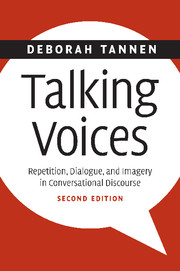Book contents
- Frontmatter
- Contents
- Acknowledgments
- 1 Introduction to first edition
- Introduction to second edition
- 2 Involvement in discourse
- 3 Repetition in conversation: toward a poetics of talk
- 4 “Oh talking voice that is so sweet”: constructing dialogue in conversation
- 5 Imagining worlds: imagery and detail in conversation and other genres
- 6 Involvement strategies in consort: literary nonfiction and political oratory
- 7 Afterword: toward a humanistic linguistics
- Appendix I: Sources of examples
- Appendix II: Transcription conventions
- Notes
- List of references
- Author index
- Subject index
4 - “Oh talking voice that is so sweet”: constructing dialogue in conversation
Published online by Cambridge University Press: 23 December 2009
- Frontmatter
- Contents
- Acknowledgments
- 1 Introduction to first edition
- Introduction to second edition
- 2 Involvement in discourse
- 3 Repetition in conversation: toward a poetics of talk
- 4 “Oh talking voice that is so sweet”: constructing dialogue in conversation
- 5 Imagining worlds: imagery and detail in conversation and other genres
- 6 Involvement strategies in consort: literary nonfiction and political oratory
- 7 Afterword: toward a humanistic linguistics
- Appendix I: Sources of examples
- Appendix II: Transcription conventions
- Notes
- List of references
- Author index
- Subject index
Summary
Oh talking voice that is so sweet, how hold you alive in captivity, how point you with commas, semi-colons, dashes, pauses and paragraphs?
Stevie Smith, Novel on yellow paper, p. 46The previous chapter examines synchronic repetition: repeating one's own or another's words within a discourse. It also, however, says a bit about diachronic repetition: repeating words from a discourse distant in time. One way that people frequently talk about a situation in which a speaker repeats another's words at a later time is the situation generally referred to as “reported speech,” generally assumed to come in two forms: “direct” and “indirect” speech, discourse, or quotation. “Direct quotation” is commonly understood to apply when another's utterance is framed as dialogue in the other's voice (“Sam said, ‘I'll come”’). “Indirect quotation” (or “indirect discourse” or “speech”) iscommonly understood to apply when another's speech is paraphrased in the current speaker's voice (“Sam said hewould come”).
In this widely-accepted schema, “direct quotation” and “indirect quotation” are clearly distinguished in the abstract, but in actual discourse many equivocal cases arise. For example, Voloshinov ([1929]1986:131) describes the power of what he calls “texture-analyzing” indirect discourse in the novel which
incorporates into indirect discourse words and locutions that characterize the subjective and stylistic physiognomy of the message viewed as expression. These words and locutions are incorporated in such a way that their specificity, their subjectivity, their typicality are distinctly felt …
- Type
- Chapter
- Information
- Talking VoicesRepetition, Dialogue, and Imagery in Conversational Discourse, pp. 102 - 132Publisher: Cambridge University PressPrint publication year: 2007
- 1
- Cited by

